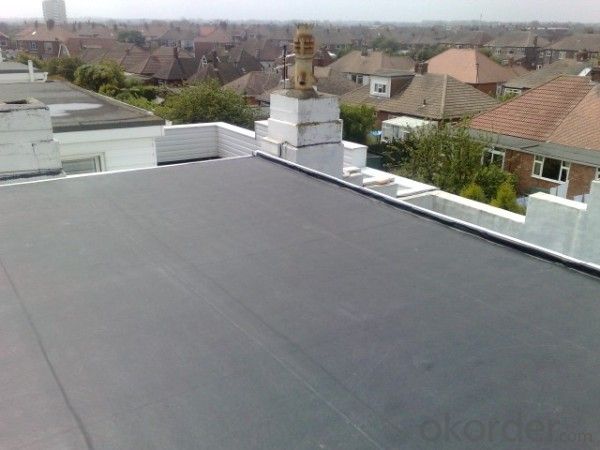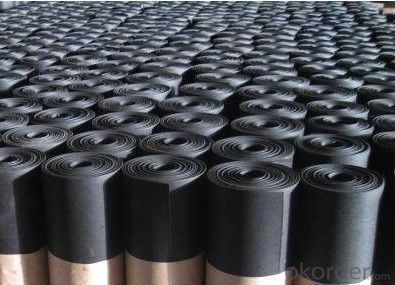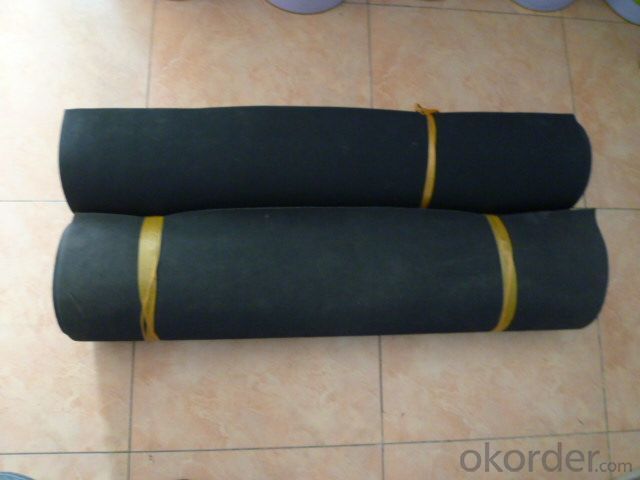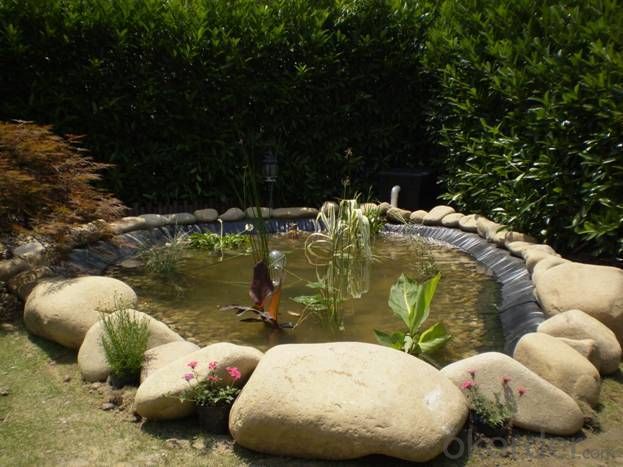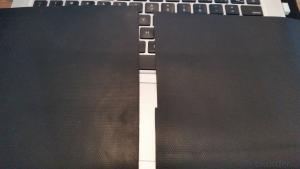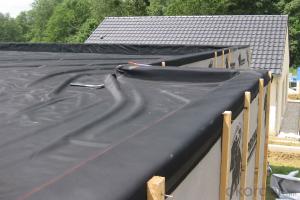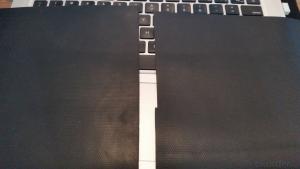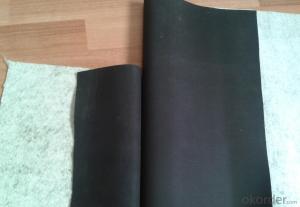EPDM Coiled Rubber Waterproof Membrane with Recycled Material
- Loading Port:
- Shanghai
- Payment Terms:
- TT OR LC
- Min Order Qty:
- 50000 m²
- Supply Capability:
- 5000000 m²/month
OKorder Service Pledge
OKorder Financial Service
You Might Also Like
EPDM Coiled Rubber Waterproof Membrane with Recycled Material
Description Of EPDM Coiled Rubber Waterproof Membrane with Recycled Material:
•EPDM waterproof sheet has excellent anti-ozone-aging performance, able to resist ultraviolet light and corrosion of many chemical corrosive materials in the atmosphere
•It has high tensile strength, high ductility and strong retractility, it has excellent crack resistance, able to effect waterproof function even with tiny vibration of buildings.
• Excellent resistance to ozone, oxidation and sunlight.
• Resistance to chemicals; resistant to most inorganic products.
Main Features of EPDM Coiled Rubber Waterproof Membrane with Recycled Material:
A.Polyester based SBS Modified Bitumen Waterproofing Membrane
a. Strong impermeability
b. High tensile strength, elongation, ability to adapt the grassroots shrinkage deformation and cracking
c. Puncture-resistant, broken resistant, tear-resistant
d. The corrosion resistance, resistance to mildew, weathering good
e. Construction convenient, hot-melt can be operated Four Seasons Construction, reliable joints
Specifications of EPDM Coiled Rubber Waterproof Membrane with Recycled Material:
| Material | EPDM Rubber |
| Size | 1.2m (width)*20m (length) or customized, weldable type 2.05m or 4m width |
| Thick | 1.2mm, 1.5mm, 2.0mm |
| Type | Vulcanized & Weldable |
| Pattern | Non-reinforced (homogeneous) |
| Certificate | ISO9001/14001 |
Applications of EPDM Coiled Rubber Waterproof Membrane with Recycled Material:
1. The substratum should be smooth, dry, clean, which can not have loosing and peeling phenomena.
2. Before application, clean up the basic level and eradicate the impurities.
3. Spread out the membrane on the substratum to loose sheet's stress. Use adhesive-glue to paint the substratum and the surface of membrane. When the adhesive is not sticky to hands, pave and press smoothly.
4. When pave the second volume of membrane, extrude 100mm of the edge of overlap of the first roll and do not paint with the adhesive. Pave the membrane on the substratum according to step so as to finish the whole pavement. When paving, do not tighten the waterproof membrane violently.
5. After that, use the special solvent to scrub the overlap joint. When it becomes fully dry , use the sheet glue to paint the both sides of the joint. Paint it again when it gets completely dry. Till the adhesive is not sticky to hands, press it smoothly and solidly.
6. Pay attention to fire prevention during application. Basement construction site shall be equipped with ventilation facilities



IMages of EPDM Coiled Rubber Waterproof Membrane with Recycled Material:




FAQ of EPDM Coiled Rubber Waterproof Membrane with Recycled Material:
1. What are we supplying?
We are specialized in producing Colorful Asphalt Roof Shingle, SBS/APP modified bitumen waterproof membrane, Self adhesive bitumen waterproof membrane, PVC waterproofing membrane, EPDM rubber roofing membrane, Single Component Polyurethane Waterproof Coating, and Spray Polyurea Waterproof Coating
.
2. How Many years experience do we have?
We have been exported to more than 20 countries in the past 15 years.
3. How long do we usually reply your request?
We always reply our customer within 24 hours.
- Q: Can a waterproofing membrane be used in conjunction with fire protection systems?
- Indeed, the utilization of a waterproofing membrane in tandem with fire protection systems is possible. Although the primary function of a waterproofing membrane is to prevent water infiltration, it can also serve as an additional safeguard against fire hazards. Numerous waterproofing membranes are engineered to possess fire-resistant qualities or exhibit fire-retardant characteristics. Consequently, they aid in impeding the spread of fire and minimizing its impact on the edifice. Furthermore, certain waterproofing membranes are specifically tailored for integration into fire protection systems, such as fire-rated roof membranes or fire-resistant sealants. These specialized membranes effectively seal off potential avenues for fire and establish a barrier to safeguard the underlying structure. In summary, the incorporation of a waterproofing membrane alongside fire protection systems contributes to the overall enhancement of a building's safety and security.
- Q: Is a waterproofing membrane resistant to mold and mildew growth?
- Indeed, the resistance of a waterproofing membrane to the growth of mold and mildew stems from its specific design, which aims to establish a barrier against moisture infiltration. This impedes water seepage and the subsequent development of mold and mildew. Through the effective sealing of the area, these membranes eradicate the favorable conditions for the proliferation of mold and mildew, such as dampness and moisture. However, it is important to acknowledge that although the membrane itself exhibits resistance to mold and mildew growth, it does not guarantee absolute protection against these issues. Proper installation, regular maintenance, and ensuring adequate ventilation play pivotal roles in preventing the long-term growth of mold and mildew.
- Q: Can waterproofing membranes be used in cold climates?
- Waterproofing membranes are applicable in cold climates. They are specially engineered to safeguard against moisture and water infiltration in diverse weather situations, including cold temperatures. These membranes are commonly constructed from sturdy and pliable materials that can endure freezing temperatures without fracturing or declining in quality. Furthermore, certain waterproofing membranes incorporate supplementary characteristics such as thermal insulation, which aids in preventing heat loss and upholding a cozy indoor atmosphere in cold climates. All in all, waterproofing membranes serve as a successful remedy for guaranteeing the soundness and durability of structures in cold weather circumstances.
- Q: Can a waterproofing membrane be used for a basement wall?
- Yes, a waterproofing membrane can definitely be used for a basement wall. In fact, it is highly recommended to use a waterproofing membrane on basement walls to prevent water infiltration and potential damage. Basement walls are particularly vulnerable to moisture due to their below-ground location, and a waterproofing membrane provides an effective barrier against water penetration. This membrane is typically applied to the exterior side of the basement wall, creating a protective layer that keeps the basement dry and prevents water from seeping into the foundation. It is essential to ensure proper installation and maintenance of the waterproofing membrane to effectively safeguard the basement from water-related issues such as leaks, mold, and structural damage.
- Q: Can a waterproofing membrane be used in conjunction with solar panel installations?
- Yes, a waterproofing membrane can be used in conjunction with solar panel installations. Waterproofing membranes are commonly used to protect roofs and other surfaces from water damage, and they can provide an additional layer of protection for solar panels. This can help to prevent water infiltration and potential damage to the solar panels and their electrical components. Additionally, waterproofing membranes can also help to extend the lifespan of the solar panel system by providing an extra barrier against moisture and other environmental factors.
- Q: Can a waterproofing membrane be used for underground fuel storage tanks?
- Yes, a waterproofing membrane can be used for underground fuel storage tanks. A waterproofing membrane acts as a barrier that prevents the penetration of water and moisture into the tank and protects the tank from corrosion and leaks. This is crucial for underground fuel storage tanks as they are vulnerable to moisture infiltration due to their location below the ground. By applying a waterproofing membrane to the tank, it helps to ensure the integrity and longevity of the tank by providing a durable and reliable waterproof seal. It is important to choose a waterproofing membrane that is specifically designed for fuel storage applications to ensure it can withstand the harsh conditions and chemicals associated with storing fuel underground.
- Q: Can a waterproofing membrane be used for balconies or terraces?
- Balconies or terraces can benefit from the use of a waterproofing membrane. These specialized membranes are designed to create a barrier against water penetration, making them an excellent choice for safeguarding outdoor areas from water damage. To apply the membrane, it is typically spread over the surface of the balcony or terrace, effectively sealing it against water infiltration and potential structural harm. Moreover, these membranes offer added protection against other elements like UV rays and extreme temperatures, which can contribute to the longevity of the balcony or terrace. In conclusion, utilizing a waterproofing membrane is a practical and efficient method to ensure the durability of balconies or terraces while safeguarding them from water-related problems.
- Q: Can a waterproofing membrane be used for basements?
- Yes, a waterproofing membrane can be used for basements. Waterproofing membranes are commonly used in basements to prevent water penetration and protect the interior space from moisture damage.
- Q: Can a waterproofing membrane be used on both interior and exterior walls?
- Yes, a waterproofing membrane can be used on both interior and exterior walls. The membrane helps prevent water penetration, providing protection against moisture for both sides of the wall.
- Q: Can a waterproofing membrane be used for below-grade parking garages?
- For below-grade parking garages, it is highly recommended to utilize a waterproofing membrane. This is due to the fact that these structures are vulnerable to water infiltration and moisture damage. Being situated underground, below-grade parking garages are particularly susceptible to water penetration. To counteract this, a waterproofing membrane acts as a barrier to prevent water from seeping into the structure and causing harm to the concrete, reinforcing steel, and other materials. Typically, the membrane is applied to the exterior walls and floor of the parking garage, creating a seamless and watertight seal. To ensure long-term protection against water ingress, it is essential to select a high-quality and durable waterproofing membrane that is specifically designed for below-grade applications. Additionally, the proper installation of the waterproofing system by trained professionals is crucial to guarantee its effectiveness.
Send your message to us
EPDM Coiled Rubber Waterproof Membrane with Recycled Material
- Loading Port:
- Shanghai
- Payment Terms:
- TT OR LC
- Min Order Qty:
- 50000 m²
- Supply Capability:
- 5000000 m²/month
OKorder Service Pledge
OKorder Financial Service
Similar products
Hot products
Hot Searches
Related keywords






